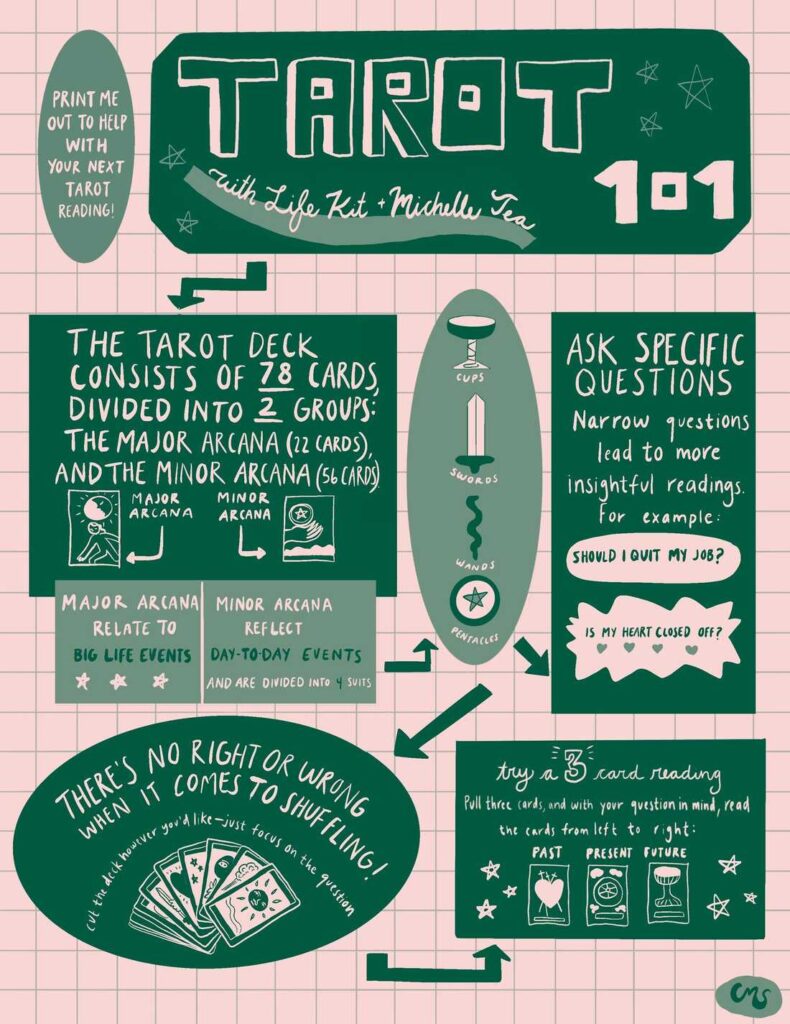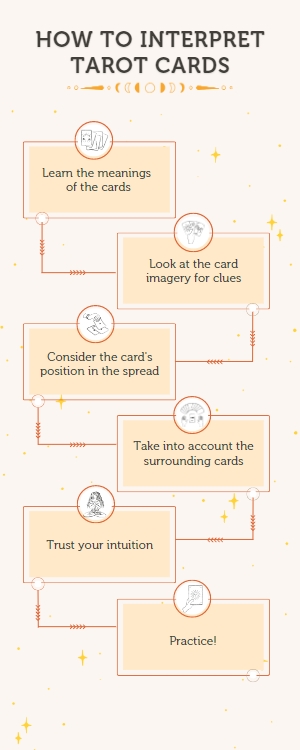Are you curious about the world of tarot cards and wondering if it’s a skill that is difficult to acquire? Well, let me tell you, reading tarot cards may seem like an enigmatic art only meant for the gifted few, but truth be told, it’s not as hard as it seems. With a little patience, practice, and an open mind, you can unlock the secrets of the tarot and begin your journey into its mystical realm. So, let’s explore the fascinating world of tarot card reading together and discover how you too can tap into the ancient wisdom they hold.
Understanding Tarot Cards
What are Tarot Cards?
Tarot cards are a deck of 78 cards that are used for divination and self-discovery. Each card in the deck holds a symbolic meaning and is believed to have the power to provide insights and guidance into various aspects of life. The deck is divided into two main sections: the Major Arcana and the Minor Arcana. The Major Arcana consists of 22 cards that represent major life events and themes, while the Minor Arcana consists of 56 cards that represent the everyday experiences and situations we encounter.
History of Tarot Cards
The history of tarot cards dates back to the 15th century, where they were initially used as a card game in Europe. Over time, they evolved into a tool for divination and spiritual exploration. The origins of the tarot are still widely debated, with some theories suggesting that the cards have roots in ancient Egypt or the Kabbalah. Regardless of their exact origins, tarot cards have captured the fascination of people across different cultures and continue to be a popular tool for seeking guidance and insight.
Different Types of Tarot Decks
There are numerous types of tarot decks available, each with its own unique symbolism and artistic style. Some of the most widely recognized tarot decks include the Rider-Waite-Smith deck, the Thoth deck, and the Marseille deck. The Rider-Waite-Smith deck is one of the most popular and widely-used tarot decks, featuring iconic and easily recognizable images. The Thoth deck, on the other hand, was designed by Aleister Crowley and contains complex symbolism and esoteric references. The Marseille deck is known for its simplicity and minimalist design. Choosing a tarot deck that resonates with you is essential for developing a deep connection with the cards.
Major and Minor Arcana
The tarot deck is divided into two main sections: the Major Arcana and the Minor Arcana. The Major Arcana consists of 22 cards, each representing a significant life event or stage of personal development. These cards often carry deep spiritual and psychological significance and provide insight into important life lessons and transformations. The Minor Arcana, on the other hand, consists of 56 cards divided into four suits: Wands, Cups, Swords, and Pentacles. These cards represent the everyday experiences and situations we encounter, offering guidance and insights into various areas of life such as emotions, relationships, intellect, and material aspects.
Skills Required for Reading Tarot Cards
Intuition
One of the key skills required for reading tarot cards is intuition. Intuition is the ability to tap into your inner wisdom and trust your gut feelings. When reading tarot cards, your intuition plays a crucial role in interpreting the symbolism and messages of the cards. It helps you connect with your intuition and listen to the whispers of your subconscious mind. Developing your intuition can be done through regular practice and by creating a sacred space for your tarot readings.
Interpretation
Interpretation is another vital skill for reading tarot cards. It involves the ability to understand and analyze the symbolism and meaning behind each card. Each card in the tarot deck holds multiple layers of interpretation, and it is up to the reader to unravel these layers and connect them with the querent’s situation or question. A good tarot reader not only memorizes the traditional meanings of the cards but also knows how to apply them in a way that is relevant and meaningful to the querent’s inquiry.
Knowledge of Tarot Symbolism
A solid knowledge of tarot symbolism is essential in order to effectively read tarot cards. Tarot cards are rich in symbolism, with each card depicting various symbols, colors, numbers, and images that hold specific meanings. Understanding the symbolism allows the reader to delve deeper into the cards’ messages and provide more accurate and insightful readings. Building this knowledge requires studying and familiarizing oneself with the traditional meanings associated with each card, as well as exploring the personal associations and interpretations that arise during readings.
Ability to Connect with the Cards
Connecting with the cards goes beyond simply memorizing their meanings or understanding their symbolism. It involves developing a personal and intuitive relationship with the cards that allows you to tap into their energy and wisdom. Connecting with the cards requires an open mind, a willingness to trust your intuition, and a genuine curiosity to explore their messages. This connection is nurtured through regular practice, meditation, and spending time with the cards outside of readings. The more you engage with the cards, the stronger your connection and understanding of their unique language and wisdom will become.
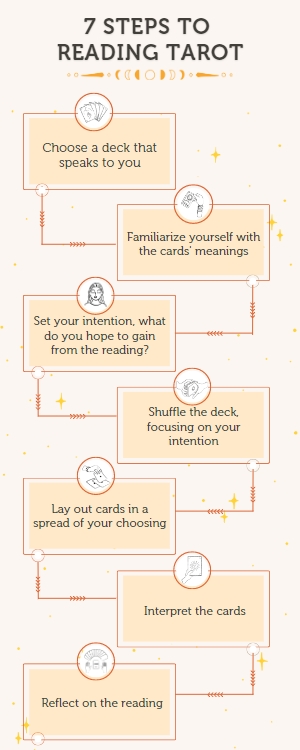
Learning Tarot Card Meanings
Study the Traditional Meanings
When learning tarot card meanings, it is essential to start with the traditional interpretations associated with each card. Traditional meanings serve as a foundation and provide a framework for understanding the cards’ symbolism. These meanings are often based on historical interpretations and have been passed down through various tarot traditions. By studying the traditional meanings, you gain a basic understanding of the symbolism and general themes associated with each card.
Understanding Card Combinations
As you progress in your tarot practice, it becomes important to delve deeper into the cards’ meanings by exploring how they interact with one another in a reading. Card combinations refer to the way multiple cards relate to each other and influence the overall message of a reading. Some combinations amplify or complement the meanings of individual cards, while others may create tension or offer conflicting advice. Developing an understanding of card combinations requires practice, observation, and a willingness to explore the unique dynamics that arise during readings.
Developing Personal Interpretations
While it is crucial to learn the traditional meanings for each card, it is equally important to develop your own personal interpretations. Personal interpretations arise from your intuition, experiences, and the connections you form with the cards. When interpreting the cards, trust your instincts and allow the images and symbols to evoke your unique insights and wisdom. Through regular practice and reflection, you will develop a personal tarot language that speaks to you and resonates with your querents.
Tarot Card Spreads
What are Tarot Card Spreads?
Tarot card spreads refer to specific layouts or arrangements of cards used during a reading. Each spread has a different purpose and provides a structure for interpreting the cards. Spreads can range from simple three-card spreads to more complex layouts such as the Celtic Cross or the Tree of Life spread. By using spreads, tarot readers can focus on particular areas of inquiry or explore different aspects of a situation, allowing for a more in-depth and nuanced reading.
Different Types of Spreads
There are countless tarot card spreads available, each designed for specific purposes. Some common spreads include the Past-Present-Future spread, the Relationship spread, and the Career spread. The Past-Present-Future spread provides insights into the timeline and progression of a situation. The Relationship spread delves into the dynamics and challenges within a relationship. The Career spread focuses on career-related questions and provides guidance on professional growth and decisions. Choosing the right spread depends on the querent’s question or focus, and the reader’s intuition and experience.
Choosing the Right Spread
Selecting the appropriate spread for a reading is essential for obtaining clarity and addressing the querent’s specific concerns. Consider the nature of the question or issue at hand and the depth of insight required. If the question is broad and requires a general overview, a simple three-card spread or a one-card draw may be sufficient. However, if the question is complex or multifaceted, more elaborate spreads may be needed to provide a comprehensive analysis. Practice with different spreads and observe how they resonate with different types of questions to find the ones that work best for you and your querents.
Position Meanings
Each position within a tarot spread carries its own significance and meaning. Position meanings provide context and additional layers of interpretation for the cards placed in those positions. They serve as guideposts to help the reader understand how each card relates to the querent’s question or situation. For example, a position representing the past may provide insights into influences and events that have shaped the current circumstances. Position meanings can be derived from personal intuition, traditional interpretations, or a combination of both. It is essential to pay attention to position meanings when interpreting a spread to gain a holistic understanding of the reading.
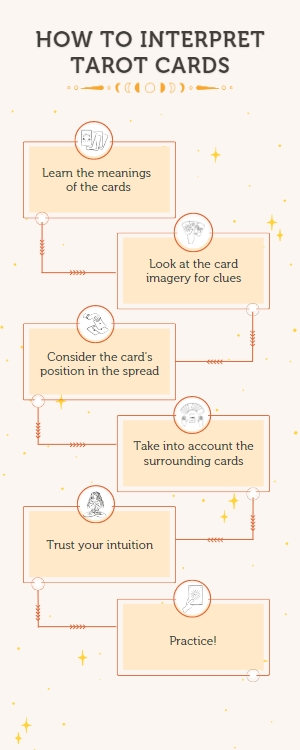
Building a Tarot Card Reading Routine
Creating a Sacred Space
Creating a sacred space is an important aspect of building a tarot card reading routine. This space serves as a container for your energy and intentions during readings, providing a sense of focus and connection. Choose a quiet and clutter-free area where you can comfortably lay out your cards and perform your readings. Surround yourself with items that evoke a sense of spirituality and serenity, such as candles, crystals, or meaningful objects. By consecrating your space and infusing it with your energy, you create an environment that enhances your readings and allows for a deeper connection with the tarot cards.
Preparing Yourself and the Cards
Before starting a tarot card reading, it is crucial to prepare yourself and the cards. Take a few moments to ground and center yourself, allowing any distractions or worries to fade away. Clear your mind and set an intention for the reading, focusing on providing guidance and insights for the querent’s highest good. Similarly, prepare the cards by shuffling them thoroughly, infusing them with your intention and energy. Some readers choose to cleanse their cards before each reading to remove any residual energies. This can be done through various methods such as smudging with sage, visualizing white light surrounding the deck, or using crystals.
Setting Clear Intentions
Setting clear intentions is a vital step in building a tarot card reading routine. Intentions act as a guiding force that directs the energy and focus of the reading. Before diving into a spread, take a moment to articulate your intention, whether it is to provide guidance, clarity, or insight. Visualize your intention manifesting through the cards and trust that the messages you receive will be aligned with this intention. By setting clear intentions, you create a sacred container for the reading and invite the energies of the cards to work in harmony with your purpose.
Grounding and Centering Techniques
Grounding and centering techniques are essential tools for maintaining focus and clarity during tarot card readings. They help you stay connected to the present moment and avoid becoming overwhelmed by external or psychic energies. There are various grounding and centering techniques available, such as deep breathing exercises, visualization, or physical movements. Find a technique that resonates with you and incorporate it into your routine before each reading. By grounding and centering yourself, you create a stable and peaceful state of mind, allowing for a more accurate and centered interpretation of the cards.
Developing Intuition and Psychic Abilities
Meditation and Visualization Exercises
Meditation and visualization exercises are powerful tools for developing intuition and psychic abilities. They allow you to quiet the mind, access deeper levels of awareness, and connect with spiritual insights. Regular meditation practice helps cultivate a calm and receptive state of mind, making it easier to tap into your intuition during tarot readings. Visualization exercises can be used to enhance your ability to connect with the cards and receive psychic impressions. For example, you can visualize yourself entering the cards and exploring their symbolism, allowing the images to come alive and reveal hidden meanings.
Enhancing Intuitive Perception
Enhancing intuitive perception is a continuous process that involves honing your awareness and sensitivity to subtle energies. Practice paying attention to your intuition in everyday life, trusting your gut feelings, and observing synchronicities or signs from the universe. When reading tarot cards, focus on developing a heightened sense of intuition by listening to your inner voice and trusting the images and impressions that come to you. The more you practice and trust your intuition, the stronger and more accurate your readings will become.
Connecting with Higher Guidance
Connecting with higher guidance is an important aspect of tarot card reading. It involves opening yourself up to spiritual insights and wisdom that go beyond your personal intuition. Many readers believe that tarot readings can be enhanced by connecting with spiritual guides, angels, or higher realms of consciousness. This connection can be established through prayer, meditation, or personal rituals. By inviting higher guidance into your readings, you tap into a collective wisdom that can offer deeper perspectives and profound insights.
Psychic Protection
Psychic protection is crucial when working with tarot cards or any other divination tool. As you open yourself up to energetic influences during readings, it is important to establish boundaries and protect your energy field. There are various ways to practice psychic protection, such as visualizing a shield of white light surrounding you, wearing protective crystals, or setting intentions for energetic boundaries. Regularly cleansing and consecrating your cards can also help maintain a clear and positive energy during readings. By practicing psychic protection, you ensure that your readings are conducted in a safe and energetically balanced space.
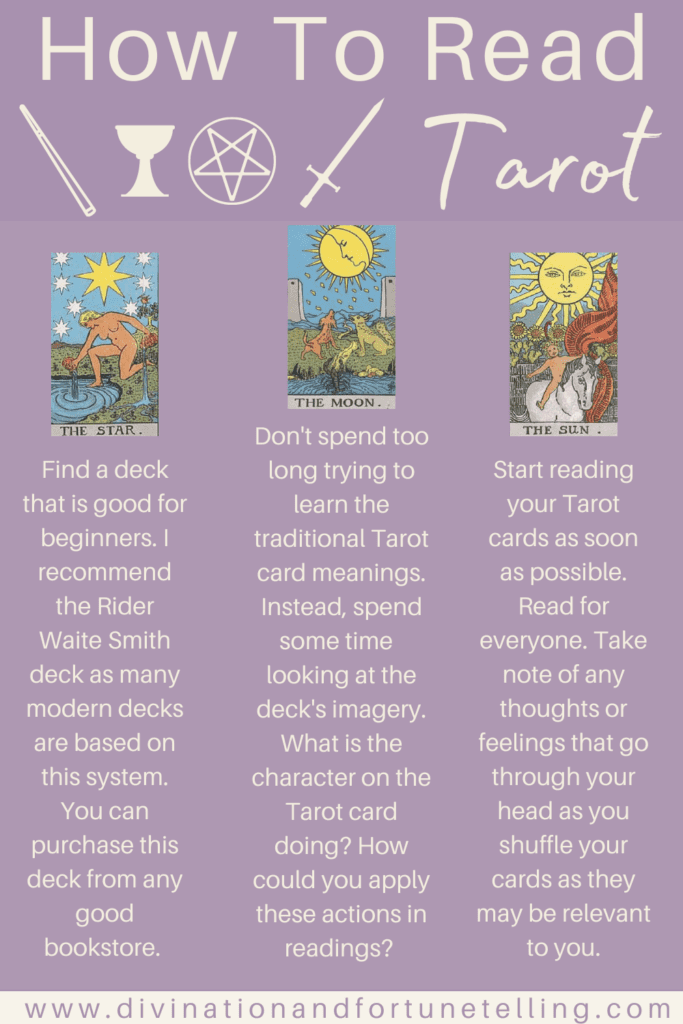
Practicing Tarot Card Readings
Reading for Yourself
Practicing tarot card readings on yourself is an excellent way to deepen your understanding of the cards and develop your interpretation skills. Start by asking specific questions or seeking guidance on personal challenges or decisions. Lay out the cards and take time to reflect on their symbolism and messages. Trust your intuition and allow the cards to guide you. Pay attention to the patterns or themes that arise, and journal your impressions and insights. By regularly reading for yourself, you gain confidence and clarity in your readings, and you develop a personal connection with your cards.
Reading for Others
Reading for others is an important step in becoming a proficient tarot card reader. When reading for others, it is crucial to establish trust, maintain confidentiality, and approach the reading with compassion and empathy. Listen attentively to the querent’s question or concern and allow the cards to guide your interpretation. Offer insights and guidance without imposing your personal opinions or judgments. Remember that tarot readings are meant to empower and provide clarity, not predict the future with absolute certainty. Practice reading for friends and family members, and gradually expand your client base as you gain confidence and experience.
Ethics and Professionalism
Ethics and professionalism are vital aspects of practicing tarot card readings. As a tarot reader, it is important to maintain integrity, respect, and confidentiality in all your interactions. Always seek consent before performing a reading, and ensure that the querent understands the nature and limitations of tarot readings. Avoid making definitive predictions or giving medical, financial, or legal advice. Establish clear boundaries and maintain the client’s trust by keeping their personal information confidential. Continuing education and staying up-to-date with ethical guidelines in the tarot community is essential for maintaining professionalism.
Working with Feedback
Working with feedback is an integral part of your growth as a tarot card reader. Seek feedback from your querents and clients after each reading to understand their experience and gain insights into your strengths and areas for improvement. Reflect on the feedback and use it to refine your interpretation skills and enhance your reading techniques. Be open to constructive criticism and maintain a growth mindset that allows you to embrace learning opportunities. Working with feedback not only helps you evolve as a reader but also builds trust and credibility in your tarot practice.
Overcoming Challenges in Tarot Reading
Dealing with Doubt and Self-Confidence
Doubt and self-confidence can present challenges for tarot card readers, especially when starting out. It is common to question your interpretations or worry about making mistakes. Overcoming doubt requires practice, patience, and building trust in your abilities. Remind yourself that tarot readings are a combination of intuition, symbolism, and personal interpretation, and there is no one right answer. Trust the messages that come through and embrace the wisdom of the cards. Surround yourself with a supportive community of fellow readers who can offer guidance and encouragement as you overcome self-doubt and gain confidence in your tarot readings.
Navigating Complex Readings
Complex readings can be overwhelming, especially when multiple cards interact with one another, or the situation at hand is intricate. When faced with a complex reading, take a step back and breathe. Approach the cards one at a time, focusing on their individual symbolism and meanings. Look for links and patterns between the cards, and trust your intuition to guide you in uncovering the layers of the reading. Simplify the spread or focus on specific aspects if necessary. Remember that complex readings offer an opportunity for deeper insights and understanding, and with practice, you will become more adept at navigating them.
Handling Difficult Questions or Clients
As a tarot card reader, you may encounter difficult questions or clients that pose unique challenges. It is important to approach these situations with empathy, compassion, and professionalism. When faced with a difficult question, create a safe and non-judgmental space for the querent to express themselves. Focus on providing guidance and insights based on the cards rather than personal opinions. Maintain respectful boundaries and avoid getting emotionally involved or attached to the outcome of the reading. If you feel uncomfortable or uncertain about a particular question, it is okay to decline or reframe it in a way that respects both the querent’s concerns and your ethical standards.
Avoiding Bias and Personal Projections
Avoiding bias and personal projections is crucial when reading tarot cards. It is essential to approach each reading with an open mind, free from preconceived notions or personal biases. Cultivate self-awareness and examine your own beliefs, experiences, and emotions that might influence your interpretation of the cards. Be mindful of any personal projections that may cloud your judgment or lead to subjective readings. Remember that your role as a tarot reader is to provide objective insights and guidance based on the cards’ symbolism and the querent’s question, rather than imposing your own experiences or opinions.
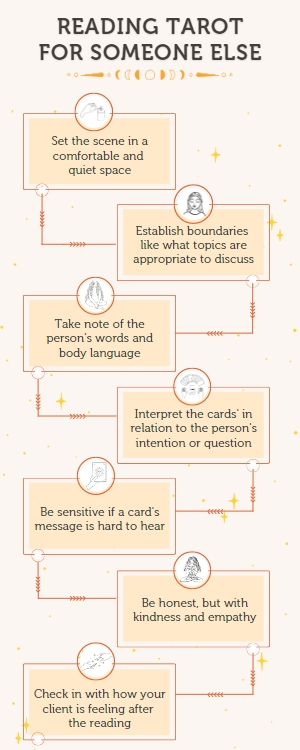
Common Mistakes to Avoid
Relying Too Much on Guidebooks
While guidebooks can be helpful references when first learning tarot card meanings, relying too heavily on them can limit your intuitive growth and interpretation skills. Guidebooks provide general interpretations, but these may not always resonate with the specific situation or question at hand. Instead of solely relying on guidebooks, approach the cards with an open mind and trust your intuition to decipher their messages. Allow your intuition to guide you towards more personalized and nuanced interpretations that address the querent’s unique circumstances.
Ignoring Intuition
Ignoring intuition is a common mistake that hinders the depth and accuracy of tarot readings. Your intuition acts as a valuable guiding force when interpreting the cards, and ignoring it can lead to misinterpretations or missed insights. Trust the impressions, feelings, and hunches that arise during a reading. Pay attention to the subtle cues or intuitive nudges that inform your interpretation. By honoring and incorporating your intuition into your tarot practice, you deepen your connection with the cards and unlock richer layers of wisdom and guidance.
Trying to Read Too Fast
Trying to read too fast is a common mistake made by tarot card readers, especially during live readings or when faced with time constraints. While it is important to respect the querent’s time, rushing through a reading can lead to hasty interpretations or overlooking important nuances in the cards. Take your time to observe and absorb each card’s symbolism and messages. Allow yourself space to reflect on each card before moving on to the next. Slow down and trust that the right insights will come to you at the right time. Remember that quality is more important than speed in delivering an accurate and meaningful reading.
Forgetting to Ground Yourself
Forgetting to ground yourself is a mistake that can impact the accuracy and quality of your tarot readings. Grounding is the practice of connecting with the present moment and anchoring yourself in the physical world. It helps you stay centered, focused, and prevent your energy from becoming scattered. Before beginning a reading, take a moment to ground yourself by visualizing roots extending from your feet into the earth or engaging in physical activities like walking barefoot on the ground. Grounding allows you to be more present and receptive during readings, enhancing your ability to interpret the cards with clarity and insight.
Resources for Tarot Card Readers
Recommended Books and Decks
There are numerous books and tarot decks available to support and enhance your tarot card reading journey. Some recommended books for beginners include “The Rider Tarot Book” by Arthur Edward Waite, “The Tarot Bible” by Sarah Bartlett, and “Seventy-Eight Degrees of Wisdom” by Rachel Pollack. These books offer detailed explanations of each card’s symbolism, various spreads, and techniques for interpretation.
In terms of tarot decks, the Rider-Waite-Smith deck is a popular choice for beginners due to its iconic and easily recognizable imagery. Other recommended decks include the Thoth deck, the Marseille deck, and the Wild Unknown Tarot. Explore different decks and find one that resonates with your personal style and intuition.
Online Tarot Learning Platforms
If you prefer online learning, there are several platforms that offer comprehensive tarot courses and resources. Some popular online tarot learning platforms include Biddy Tarot, Tarot Academy, and Learn Tarot. These platforms offer a combination of video tutorials, written materials, and interactive activities to support your tarot learning journey. Take advantage of these resources to deepen your understanding of the cards, improve your reading techniques, and connect with a community of like-minded learners.
Joining Tarot Communities
Joining tarot communities can provide valuable support and guidance as you continue to develop your tarot reading skills. Seek out online forums, social media groups, or local meetups where tarot enthusiasts gather to share their knowledge and experiences. Engage in discussions, ask questions, and offer your insights to contribute to the community. Tarot communities offer a space to connect with fellow readers, exchange reading tips, and gain inspiration for your own tarot journey.
Finding a Mentor
Finding a mentor can be a transformative experience for your tarot card reading practice. A mentor can provide guidance, personalized feedback, and the opportunity to learn from their years of experience. Look for experienced tarot readers in your community or online who offer mentorship programs or workshops. A mentor can provide invaluable insights, assist in overcoming challenges, and accelerate your growth as a tarot card reader.
In conclusion, reading tarot cards is a journey of self-discovery, intuition, and connection. It requires the cultivation of skills such as intuition, interpretation, knowledge of tarot symbolism, and the ability to connect with the cards. Learning tarot card meanings involves studying traditional meanings, understanding card combinations, and developing personal interpretations. Tarot card spreads offer structures for interpreting the cards, and building a tarot card reading routine involves creating a sacred space, preparing yourself and the cards, setting clear intentions, and grounding and centering techniques. Developing intuition and psychic abilities is also important, as well as practicing tarot card readings for yourself and others while maintaining ethics and professionalism. Overcoming challenges and avoiding common mistakes requires addressing doubt and self-confidence, navigating complex readings, handling difficult questions or clients, and avoiding bias and personal projections. Utilizing resources for tarot card readers such as books, online learning platforms, tarot communities, and finding a mentor can further support your tarot journey. Is it hard to read tarot cards? It takes time, practice, and dedication, but with patience and the right guidance, anyone can learn to read tarot cards and unlock the wisdom they hold within.
